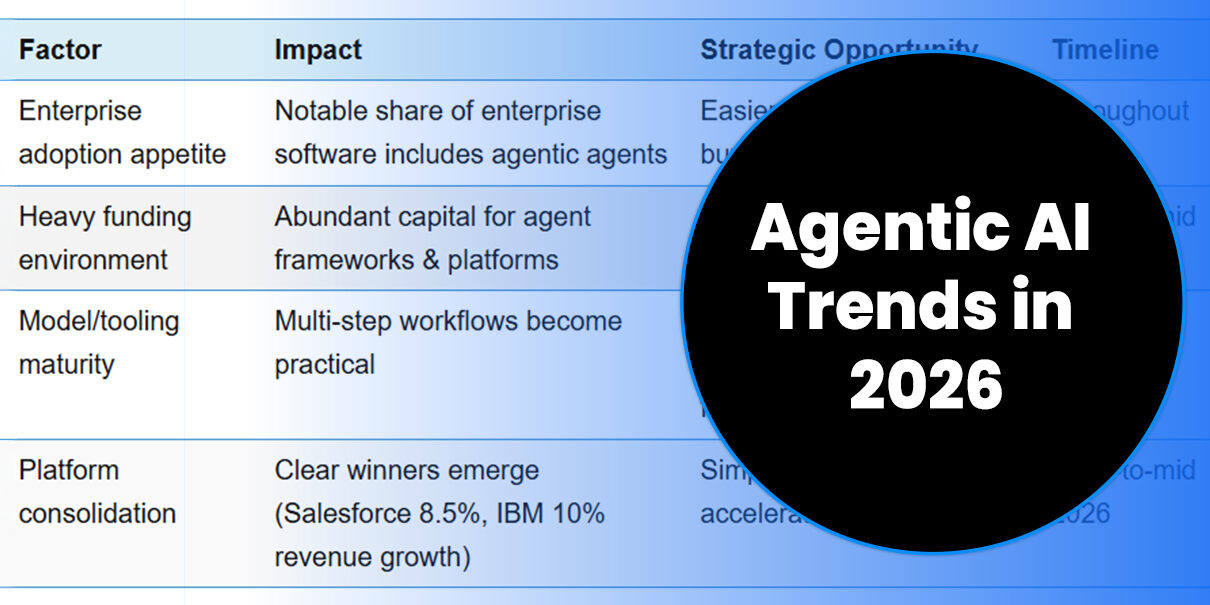The agentic AI landscape in 2026 presents a complex matrix of accelerating opportunities and emerging constraints. Unlike traditional AI systems that respond to prompts, agentic AI operates autonomously, making decisions, orchestrating tasks and pursuing business objectives without constant human oversight.
For digital transformation leaders, 2026 represents a critical decision point where market forces will either propel organizations forward or create operational barriers that define competitive positioning for years to come. Understanding these specific tailwinds and headwinds is essential for strategic planning.
We’ll cover the agentic AI trends of 2026 by analyzing key accelerating forces and significant constraining factors that every enterprise must navigate to succeed with agentic AI implementation.
Factors Accelerating Agentic AI in 2026
| Factor | Impact | Strategic Opportunity | Timeline |
|---|---|---|---|
| Enterprise adoption appetite | Notable share of enterprise software includes agentic agents | Easier pilots, stronger buyer interest | Throughout 2026 |
| Heavy funding environment | Abundant capital for agent frameworks & platforms | Competitive pricing, expanded solution options | Early-to-mid 2026 |
| Model/tooling maturity | Multi-step workflows become practical | Faster time-to-value, reduced engineering friction | Immediate |
| Platform consolidation | Clear winners emerge (Salesforce 8.5%, IBM 10% revenue growth) | Simplified integration, accelerated distribution | Early-to-mid 2026 |
Rapid Enterprise Adoption: Big Appetite for Agents Inside Apps
Enterprises across industries are sprinting to add agentic features to their applications, creating unprecedented demand for task orchestration and intelligent assistants. Analysts expect a notable share of enterprise software to include agents by 2026, driving substantial pilot deployments and increased spending.
Strategic Implications
Heavy Funding and Buyer Spending on AI Infrastructure & Services
VC and corporate AI investment remained substantial through 2025, producing abundant capital for startups building agent frameworks and orchestration layers. This funding environment fuels aggressive product launches while enterprises benefit from expanded solution options and competitive pricing.
The impact was evident at industry events like Fall Finovate 2025 in NYC, where 7t.ai participation revealed intense enterprise interest in practical agentic solutions.
Strategic Implications
Improved Model and Tooling Maturity for Multi-Step Workflows
Progress in model chain-of-thought reasoning, fine-tuning capabilities and API tool integration has reached a critical threshold by 2026. Engineering friction for implementing practical multi-step agent flows has decreased substantially, enabling faster time-to-value for customer operations, research assistance and business process automation.
Strategic Implications
Platform Winners and Ecosystems Coalescing
A small set of orchestration providers are emerging as default enterprise choices, evidenced by strong growth projections: Salesforce Agentforce targeting 8.5-9% YoY growth and IBM WatsonX projecting approximately 10% growth. Early partnerships with platform winners can accelerate distribution and reduce integration complexity.
Strategic Implications
Constraints Slowing Agentic AI in 2026
| Constraint | Impact | Risk Mitigation Required | Timeline |
|---|---|---|---|
| EU AI Act compliance | More legal and engineering documentation required, risk assessments, deployment delays | Compliance-first design, more legal/engineering work for documentation | Mid-2026 |
| Compute cost pressure | Higher infrastructure costs for agent farms | Cost optimization, hybrid cloud strategies | Throughout 2026 |
| Market valuation risk | Startup capital pressure, vendor stability concerns | Vendor risk assessment, contingency planning | Mid-2026 |
| Regulatory patchwork | Cross-jurisdiction complexity, legal uncertainty | Region-by-region strategies, compliance overhead | Ongoing |
| Trust/UX gaps | Human-in-loop requirements, slower rollouts | Hybrid workflows, change management focus | Throughout 2026 |
Regulatory Compliance Cycle — EU AI Act Full Applicability in 2026
The EU AI Act becomes largely applicable in August 2026, driving organizations to tighten controls and documentation. For agentic systems with autonomous decision-making capabilities, this raises substantial compliance burdens and will slow cross-border rollouts.
Strategic Implications
Compute & Chip Supply / Cost Pressure
Demand for High Bandwidth Memory (HBM) and AI-grade silicon has tightened markets, putting infrastructure costs under significant pressure. Higher costs in 2026 will make large-scale, continuously running agents more expensive, necessitating cost optimization strategies and hybrid architectures.
Strategic Implications
Market Turbulence & Valuation Correction Risk
Strong 2024-2025 funding inflated valuations across AI startups, with analysts warning of potential corrections. If funding cools, smaller agent startups may face capital pressure affecting product development and support capabilities, resulting in tighter due diligence and slower funding rounds.
Strategic Implications
Regulatory Patchwork (US Federal and State Law) and Uncertainty for High-Risk Agent Use
While the EU creates pan-regional rules, the US remains a patchwork of guidelines and state laws. This mixed regulatory environment raises legal uncertainty for cross-jurisdiction deployments, particularly in finance, healthcare, and autonomous systems, requiring region-by-region compliance strategies.
Strategic Implications
Operational/UX Gaps and Trust Problems for High-Stakes Workflows
Agentic systems making autonomous decisions in critical areas must clear higher trust thresholds. Most organizations will require human-in-the-loop designs and extended validation cycles, meaning slow rollout timelines for fully autonomous use cases with hybrid workflows dominating implementations.
Strategic Implications
Capitalize on Agentic AI Trends with 7T
Success means capitalizing on agentic AI trends now — establishing platform partnerships, launching pilots, building compliance processes, and developing cost optimization strategies. The competitive window is narrowing as market forces accelerate adoption timelines and regulatory frameworks take effect.
At 7T, we’re guided by our core philosophy of “Business First, Technology Follows.” As such, the 7T development team works with company leaders seeking to solve problems and drive ROI through Digital Transformation and innovative technologies like agentic AI.
7T has offices in Dallas and Houston, but our clientele spans the globe. If you’re ready to discuss your agentic AI and Digital Transformation project, contact 7T today.








